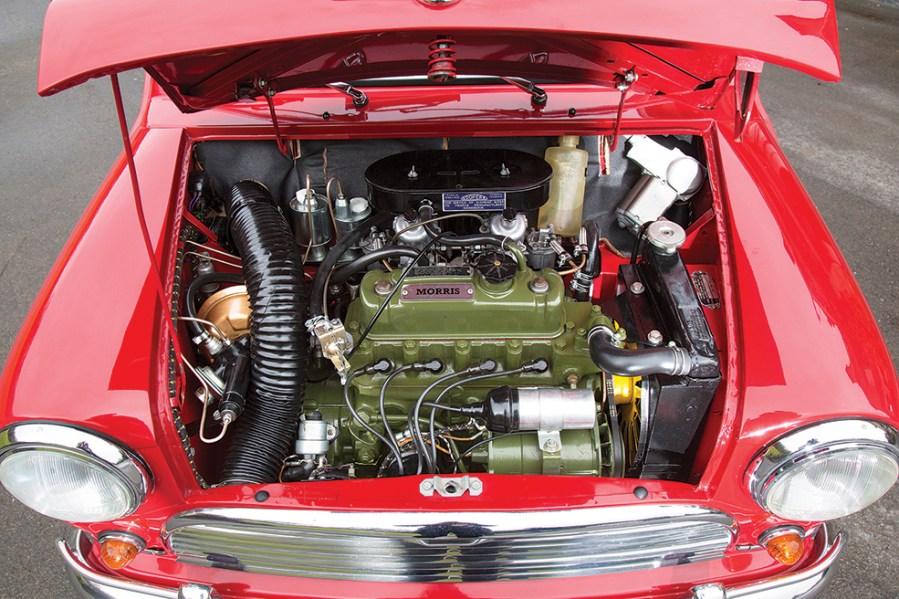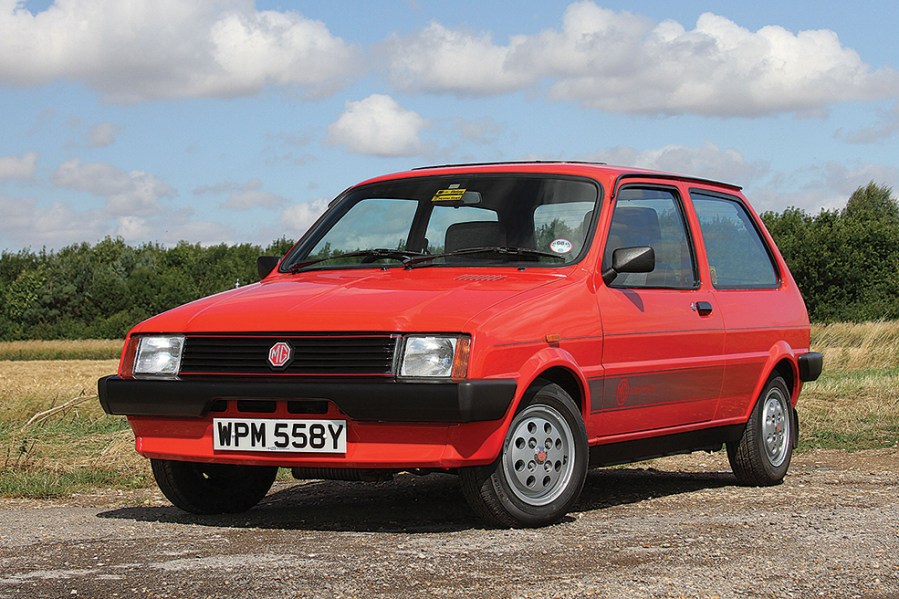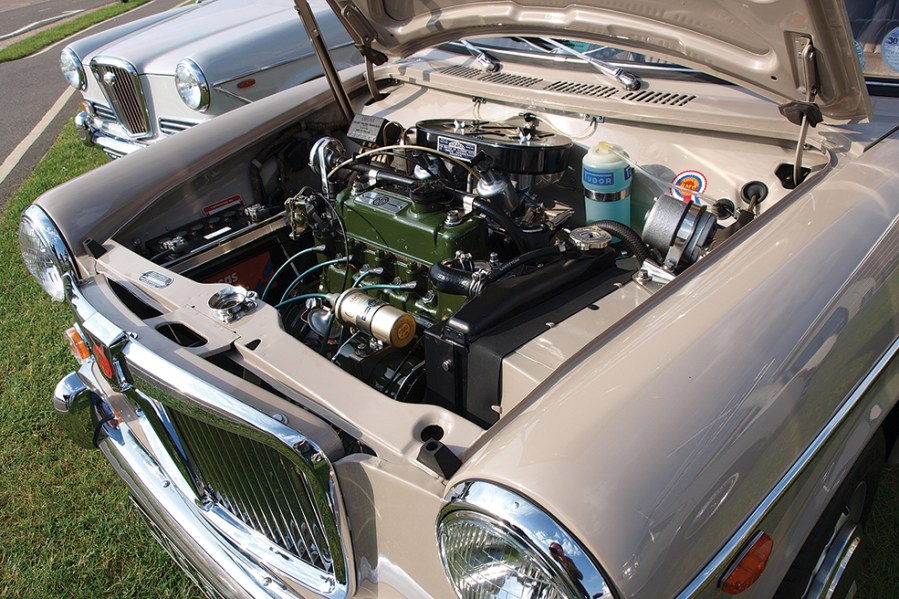A difficult act to follow, the BMC A-Series engine worked its magic for almost half a century in a vast variety of guises and in a huge range of cars. Here are our favourites
There’s always a strong argument for not fixing something that isn’t broken, but back in 1980, anyone excitedly peering under the bonnet of the newly released Austin Metro might’ve been rather disappointed to see the familiar A-Series rocker cover staring back at them. Never mind that it had been heavily tweaked; British Leyland’s brand-new hope to beat the world was still fitted with an engine that made its debut in the A30 of 1951.
But some things can transcend the desire for the new-fangled technology, and the venerable A-Series has proven to be one of them. It has been fitted to various best-selling cars spanning multiple decades, in a seemingly infinite variety of capacities and states of tune along the way. Indeed, over 14 million units were built.
The engine was initially the work of an independent Austin company but when Austin and Morris Motors were amalgamated to form the British Motor Corporation (BMC), it would be used to power the A30’s bitter market rival, the Morris Minor. In 1956, capacity was increased to 948cc, but that was just the start of a myriad of different engine sizes and transmission layouts spanning almost 50 years.
Several attempts were made to replace the old cast iron motor over the years, but all in vain. Even though the fashion was for high-revving OHC engines, the A-Series still boasted impressive torque and very competitive fuel economy, making investment for costly new designs difficult to justify.
Instead, the existing A-Series would be improved as BL chairman Michael Edwardes delicately trod between keeping the firm going on government hand-outs and turning out the lights. The result was the A-plus motor, which was the result of a £30 million development programme. Clever revisions meant slightly higher power outputs and extended service intervals without affecting the engine’s torque characteristics.
As well as seeing service in the Allegro, Metro and Mini, the A-plus also powered the 1.3-litre versions of the Maestro and Montego.
Over the years, there was a turbocharged version, single and twin-point injected variants and even a diesel type used to power BMC tractors. A reproduction Cooper S block looks set to be available from Mini Spares in the future, and investigations into complex direct port injection continue. Clearly, there’s plenty of life in the old stager yet, so here’s a look back at the cars that helped make the A-Series so respected.

Austin A30/A35
The A-Series made its maiden appearance in the innovative A30, a car unveiled at Earls Court in October 1951 as a competitor for the Morris Minor. Styled in-house by Ricardo ‘Dick’ Burzi, it was the first Austin to be built with a monocoque construction, making it lighter than rivals. Originally, only a four-door version was offered, but a two-door variant followed in 1953, with a van and a van-based Countryman estate arriving a year later.
The 28bhp 803cc A-Series meant it could get close to 70mph which, combined with fuel consumption of around 40-45mpg, made it a major step forwards in the small car class. It was also considerably cheaper than the Morris Minor, leading to strong sales that would eventually reach almost 225,000.
In September 1956, the A30 became the A35. The most significant upgrade was the engine capacity increase from 803 to 948cc, which upped power to 34bhp. Externally, it got a bigger window and a painted grille rather than chrome. The launch of the A40 Farina in 1958 and Mini in 1959 would spell the end for the salon models, but the Countryman hung around until 1962, and the van all the way to 1968.
In total, around half a million A30/35s were made and they still have a strong following. Very much an established classic, they’re a popular choice for historic motorsport, too. A good, usable road car can still be had for under £5000.
Morris Minor
Recognised the world over, the Minor is the archetypal British classic car. Early cars were powered by the aging 27bhp 918cc sidevalve engine, but after BMC was formed in 1952, the Morris Minor Series II appeared with the 803cc A-Series from its A30 rival. It was only fitted to the four-door at first, but the two-door and Tourer got the new motor in early 1953. Later that year the wood-framed Traveller was added to the range, followed by van and Pick-up versions.
The Series 3 Minor of 1956 got the same 948cc engine as the A35 and became known as the Morris 1000 – identifiable by a curved one-piece windscreen rather than the old split arrangement and larger rear window. Five years later, the Morris Minor 1000 became the first British-built car to sell more than a million units.
The larger 948cc A-Series finally provided the power to match the Minor’s handling, and even more so after September 1962 when a 48bhp 1098cc engine went in. That would see the Minor through to its end; convertibles were dropped in June 1969 and saloons in November 1970, though Travellers lasted until April 1971. The A-Series did live on in a Morris-badged car though, powering the 1.3-litre Marina and its Ital replacement. Over the years, many of these engines have subsequently been used to give a Minor a performance hike.
The Minor has survived in strong numbers, keeping prices very reasonable. Classified adverts usually feature plenty of well-cared for Series 2 or Minor 1000 saloons priced at anywhere between £4000 and £6500, while projects can be picked up for under £2500.
![]()
Austin-Healey Sprite and MG Midget
Launched in May 1958, the exciting yet economical Austin-Healey Sprite was ideal for a Britain that was increasingly optimistic, but had only recently emerged from fuel rationing in the wake of the Suez Crisis. Designed by the Donald Healey Motor Company, it featured a very simple monocoque body endowed with parts from the BMC inventory, including a tuned version of the 948cc A-Series with twin carbs.
The car’s upright headlights in pods on the bonnet saw the car earn its famous ‘Frogeye’ nickname. But while successful, it only lasted three years before a Mk2 version was introduced with a separate bonnet and wings, plus an opening boot. As the Sprite was already made at MG’s Abingdon factory, BMC decided to launch an Octagon-badged version too, reviving the Midget name from MG’s past. The two models have long since collectively been known as ‘Spridgets’.
Mirroring the rest of the BMC range, the 948cc motor made way for the more powerful 1098 version in 1962. For at least five years thereafter, development was almost continuous. The Mk3 Sprite and Mk2 Midget arrived in 1964, with various upgrades including wind-up windows, a better dash and revised rear suspension. The 1098 motor, meanwhile, got a stiffer crank and larger main bearings, with tweaks made to the cylinder head and a new four-branch manifold added too. It wasn’t as quick as a contemporary Mini Cooper S, but the Sprite was over £80 cheaper.
It took two more years for BMC to launch the Mk3 and Mk4 versions of the Midget and Sprite with the 1275cc engine used in the Mini Cooper S, but even then, it was some 12bhp down. Without that handicap, it could’ve been faster than the more expensive MGB.
Changes under the new BLMC management from 1968 were fairly minor until a big facelift in 1970, but despite all the change the 1275 stayed. It was in 1974 that US regulations necessitated ditching the A-Series in favour of the Triumph 1493cc unit fitted to the Midget’s market rival, the Spitfire. This was joined by big black plastic bumpers and increased ride height. Although top speed increased a fraction, the larger unit was not as rev happy as the A-Series and it changed the character of the car.
The Midget 1500 has a decent following, but it’s still the A-Series cars that are most desirable. A good example will cost around £7000-£8000, with tip-top early cars and round-wheel arch versions lately reaching five figures.

Mini
The Mini is the stand-out A-Series success story. Another Issigonis marvel, it saw the engine altered from its traditional in-line layout by being mounted transversely, with gearbox in the sump sharing the engine oil and driving the front wheels. The engine now displaced 848cc, as the 948cc prototypes were deemed too fast when clocked at 92mph!
It was launched as the Austin Se7en and Morris Mini-Minor in August 1959. In January 1960 a van version arrived, and later that year the Austin Se7en Countryman and Morris Mini Traveller estate versions were released. A pick-up was also added in 1961.
But the big news was the Cooper. The Mini was crying out for more power, and that’s what it got in 1961 when John Cooper persuaded BMC to build a run of 1000 1-litre Minis to homologate them for competition use. It got a 55bhp 997cc engine with twin carbs and was an immediate success.
The plush Riley Elf and Wolseley Hornet models were initially launched with the 848 motor, but in 1962 they became the first Mini derivative to get a decent mid-range boost courtesy of the 38bhp 998cc A-Series. Two years later, the Mini Cooper got a 998cc motor too, but an uprated version with twin carbs. It wasn’t any more powerful than the old 997, but it was more refined.
The real giant-killer arrived in 1963, with the launch of the Cooper S. Initially powered by a 70bhp 1071cc A-Series, it propelled Paddy Hopkirk to the Monte Carlo Rally victory in 1964 that kickstarted the Mini’s iconic status. It was joined by the 76bhp 1275cc version in 1964, and just before the 1071 was dropped, a 970 S homologation special joined the range. Only 963 of these 65bhp screamers were built, leaving the big capacity 1275cc version to become the Cooper S mainstay. It survived into Mk2 and Mk3 guises before it was discontinued in 1971 as result of cost-cutting measures.
The 1275cc remained part of the range under the bonnet of the 1275GT, albeit in de-tuned single carb form. The rest of the rationalised range featured either the 848 or 998cc units, but in 1975, Clubman models got a 1098cc motor rather than the 998. The 1098 also powered the limited edition 1100 Special.
The launch of the Metro in 1980 would see the 848, 1098 and 1275cc engines all lost from the range. For the 1980s, UK-built Minis would be fitted with the 998cc engine only, coinciding with a long period of ‘stickers and trim’ special editions.
But in 1990, the Cooper was back – albeit with a single carb 1275cc motor and a catalytic converter. Even so, the Rover Cooper was an instant success and gained single point fuel injection in 1991. The following year, the 998cc was ditched from the range entirely and replaced by a detuned carb-fed 1275, but by late 1994 all new Minis were fuel injected. The Cooper was the most powerful, but in late 1996 all models got the same 63bhp twin-point set-up developed to satisfy new EU regulations. In this guise, the A-Series would see the Mini out until the last one rolled off the production line in 2000.
After years as a cheap first car, it’s now routine to pay £3000 for a running project Mini in need of bodywork repairs, while a decent 1960s Cooper S can make £50,000. Even the once-maligned 1275 GT can attract £20,000 or more.

BMC 1100/1300 (ADO16)
Having penned the Minor and Mini, Alec Issigonis repeated the magic with the BMC 1100/1300 (ADO16). The innovative new range played on the Mini’s basic formula but added more space, greater comfort and neat Pininfarina styling. Clearly it worked, for it went on to be Britain’s best-selling car for car for eight years between 1963 and 1971.
A V4 engine was considered, but in the end the trusty A-Series went in, featuring the same 1098cc capacity as now fitted to the Minor but with the Mini’s traverse layout. Combined with a first outing for Alex Moulton’s Hydrolastic suspension, the ADO16 won plenty of plaudits and would eventually be assembled all over the world.
The car was first launched in August 1962 as the Morris 1100, but in complex BMC fashion, badge-engineered versions came thick and fast. The faster twin-carb MG 1100 was next, followed by the Austin 1100 in 1963 and the plush Vanden Plas Princess version soon after. The mid-range Wolseley 1100 and Riley Kestrel versions were last to arrive in 1965, featuring the same motor as the MG. That year also saw four-speed automatic transmission become an option and, in 1966, the three-door estate made famous by Basil Fawlty’s branch-wielding exploits joined proceedings.
With the ADO16’s rival, the Ford Cortina, offering bigger engines, the summer of 1967 saw BMC finally offer the 1275cc engine in the MG, Riley, Wolseley and Vanden Plas models. Once again, this wasn’t the full fat one from the Mini Cooper S, but a less exotic 58bhp version. By the time the Mk2 version with cropped rear fins was launched across the range that October (though the upmarket versions weren’t yet designated as such), that same 1275 was fitted to new Austin and Morris 1300 models, which supplemented the 1100 versions. Only from 1968 did the upmarket versions get their power advantage back, with the Wolseley and VP getting 65bhp and the MG and Riley (now without the Kestrel name) up to 68bhp. The latter pair were soon upped to 70bhp, but the Riley (and the entire marque) was dropped in 1969 and the sporty 70bhp Austin and Morris 1300GT models launched instead.
By the time the two millionth ADO16 was produced at the end of June 1971, the Morris had been withdrawn from the home market to make way for the Marina. The MG followed a month later, but the Wolseley version lasted until 1973. The remaining models survived until 1974, with the final car – a Vanden Plas Princess 1300 – rolling off the line in June.
It’s replacement, the Allegro had already been released by then. But though it retained the A-Series in 1098, 1275 and later 998cc A-plus forms, sales were never as strong. Rust killed many an ADO16, but a good one is a popular commodity. Values didn’t justify expensive restoration for years, but now the GT or upmarket versions can command well into five figures.

Metro
And so on to the Metro. Initially conceived to replace the Mini, it took the basic ingredients and added much more interior space, a practical hatchback boot and a more comfortable ride. That made it a very strong seller, especially in the early years.
The A-plus 998 and 1275cc engines may have looked similar to that first 803cc unit, but they were made up of completely different components. Besides, the Fiesta – the benchmark for small cars in 1980 – was still relying on an old pushrod Kent engine that was also decades old. Metro trim levels ranged from the plain 1.0 to the HLS range-topper, with HLE economy model gaining taller gearing.
The sporty version was the 1.3 S, but in 1982 the MG Metro arrived to revive the famous badge two years after Abingdon’s closure. Power was up to 72bhp from the 1275 motor, courtesy of a big-valve and a hotter camshaft amongst other tweaks. To continue the badge engineering theme, a plush Vanden Plas version was also launched.
In 1983, the hottest factory A-Series variant of all arrived. With development help from Lotus, the MG Metro Turbo got a Garrett T3 turbo and a unique engine with different internals and a special head. It produced 93bhp, but it could’ve been much more with a stronger gearbox. This engine also went in the factory approved ERA Mini Turbo, produced later in the decade.
The A-Series Metros lasted until the launch of the K-Series cars in 1990, when the need for a fifth gear finally became too much. Nevertheless, when the Metro finally bowed out as the Rover 100 in 1997, the A-Series powered Mini would go on to live for another three years.
The Metro’s rarity has seen values firm up of late, but a budget of £1000-£1500 will still secure a running 1.0 or 1.3 model, with low-mileage survivors around £2500-£3500. For presentable MG models, expect to pay a couple of thousand more. A pristine Turbo can go for over £10,000.







